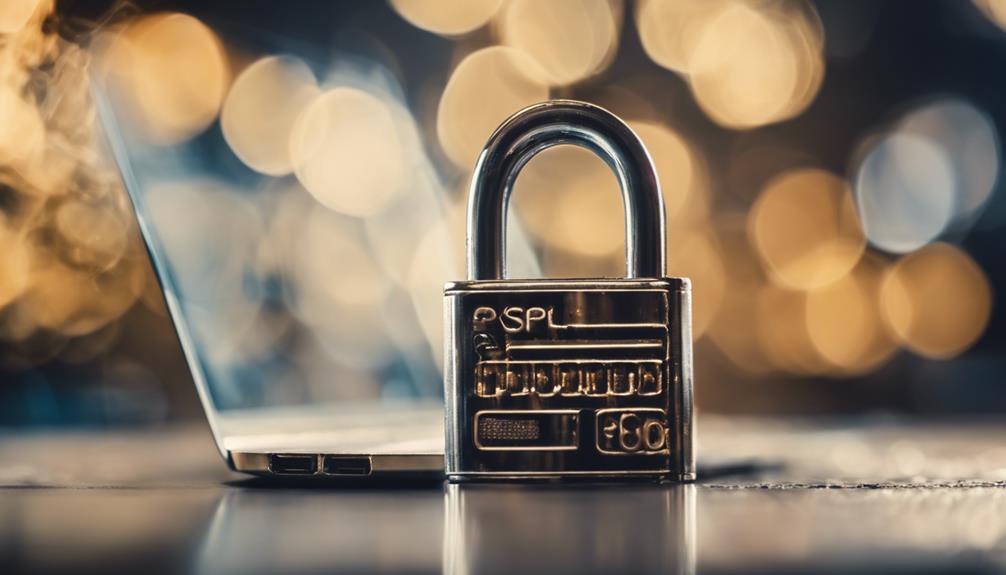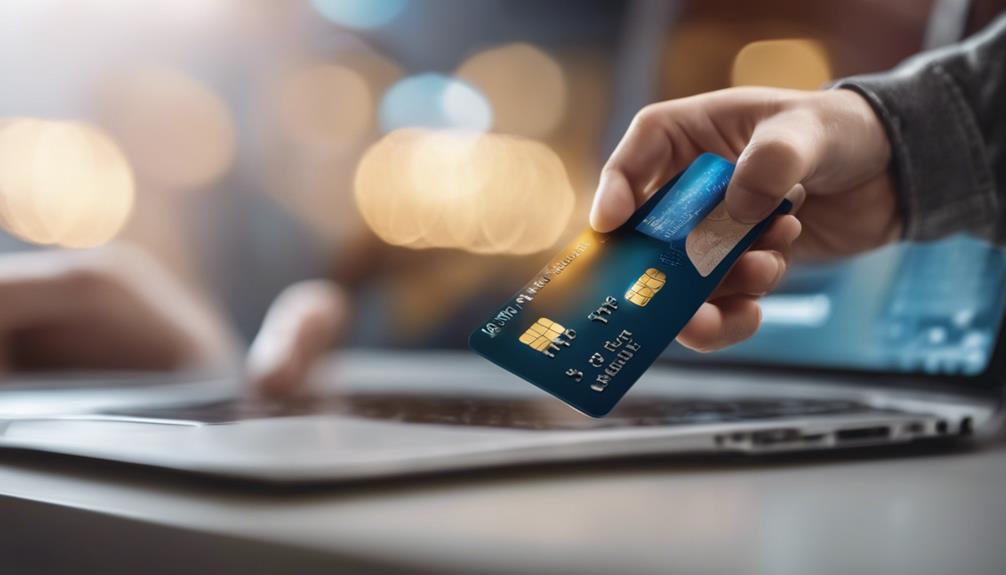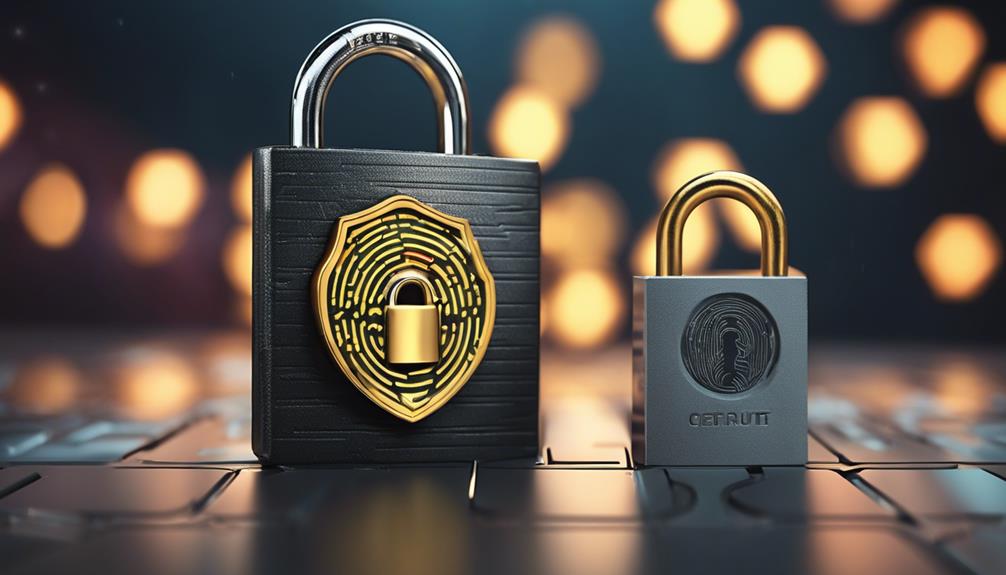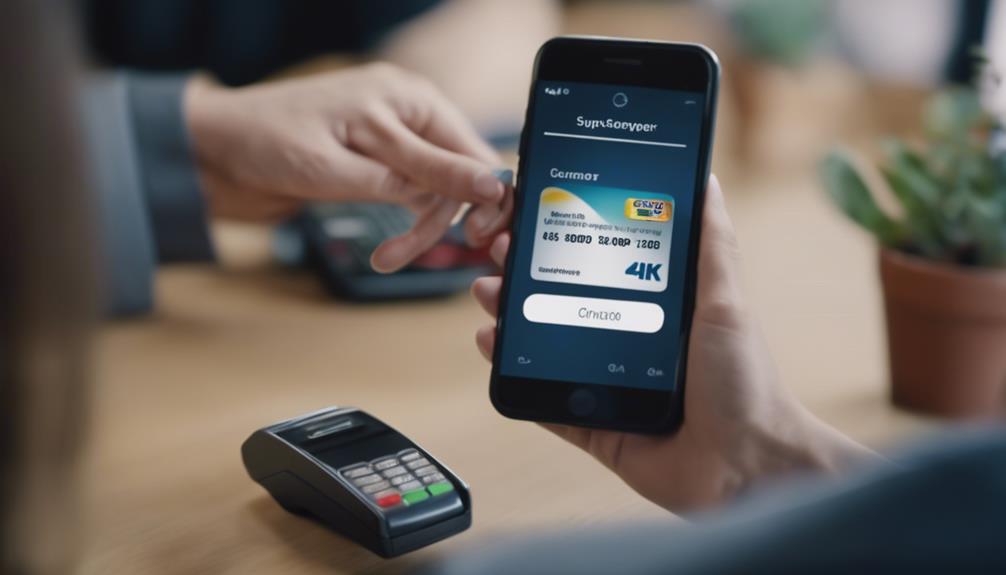To enhance payment security, prioritize PCI compliance standards. Adhere to PCI DSS for safeguarding cardholder data. Utilize tools like Tokenization, 3D Secure, and Data Encryption. Tokenization replaces card data with random tokens to guarantee security. 3D Secure adds an authentication layer for eCommerce transactions. Implement Multi-Factor Authentication and Address Verification System for added security. Protect online transactions with Card Verification Value. These measures fortify defenses against fraudulent activities and are essential for securing sensitive information. Discover more ways to enhance payment security and prevent fraud effectively in your business operations.
Key Takeaways
- Implement Tokenization for secure payment data handling and PCI compliance.
- Utilize 3D Secure for an additional layer of authentication in eCommerce transactions.
- Enable Multi-Factor Authentication to prevent unauthorized access and fraud.
- Use Address Verification System and Card Verification Value for added security measures.
- Adhere to PCI compliance standards and regularly update security features for protection.
PCI Compliance: Essential Security Standards

To maintain strong payment security, businesses must adhere to essential PCI compliance standards. Compliance with the Payment Card Industry Data Security Standard (PCI DSS) is vital for safeguarding cardholder data. These global security requirements are designed to protect sensitive information and prevent fraudulent activities.
Depending on the volume of transactions, businesses are categorized into different PCI levels, each with specific compliance requirements. To achieve compliance, it's recommended to reference a detailed PCI Checklist outlining necessary steps.
Payment Security Tools and Features

Enhance your payment security with a range of effective tools and features designed to protect sensitive data and prevent fraudulent activities. Consider options such as Tokenization, 3D Secure, and Data Encryption to safeguard your information.
Tokenization replaces card data with random tokens, enhancing security and ensuring PCI compliance. 3D Secure adds an extra layer of authentication for eCommerce transactions, deterring unauthorized card use.
Essential security measures like Multi-Factor Authentication and Address Verification System are important to implement. Utilize Card Verification Value for added security in online transactions.
Understanding and utilizing these features will help you select the right security methods for your payment transactions, ensuring a secure and trustworthy payment environment.
Implementing Tokenization for Data Protection

Utilize tokenization as a secure method for protecting sensitive data in your payment transactions. Tokenization replaces critical card data with random tokens, generated and securely stored during transactions. This process shields your information, mitigating data exposure risks and bolstering payment security.
Not only does tokenization enhance security, but it also aligns with PCI compliance standards for safely storing credit card details. By adopting tokenization, you fortify your defenses against potential fraudsters seeking to exploit vulnerabilities in your payment processes.
Make tokenization a cornerstone of your data protection strategy to safeguard sensitive information effectively and maintain the integrity of your payment transactions.
Enhancing Security With 3D Secure

Boost your online payment security with the added protection offered by 3D Secure authentication.
3D Secure provides an extra layer of security for eCommerce transactions by redirecting customers to a secure page for password verification. This process helps prevent unauthorized card use and enhances overall online payment security.
Particularly useful for high-risk transactions, 3D Secure is effective in thwarting fraudulent activities. By implementing 3D Secure authentication, you greatly reduce the risk of unauthorized access to sensitive payment information.
Stay ahead of potential threats and safeguard your transactions with this additional security measure in place.
Multi-Factor Authentication for Fraud Prevention

To further fortify your online payment security measures, consider implementing Multi-Factor Authentication for enhanced fraud prevention. Multi-Factor Authentication (MFA) requires users to provide two or more verification factors to access their accounts, adding an extra layer of security.
By combining something you know (like a password), something you have (like a phone or token), or something you are (like a fingerprint), MFA greatly reduces the risk of unauthorized access or fraudulent activities. This additional step makes it harder for cybercriminals to breach your account, as they'd need more than just a password to gain entry.
Implementing MFA can greatly enhance your payment security and protect your sensitive information from potential threats.
Importance of SSL and TLS Encryption

When considering online payment security, understanding the importance of SSL and TLS encryption is vital to safeguarding sensitive data. These encryption protocols play a critical role in securing information exchanged during transactions. Here are three key reasons why SSL and TLS encryption are essential:
- Data Protection: SSL and TLS encrypt sensitive information like credit card numbers and addresses, making it unreadable to unauthorized parties.
- Enhanced Security: SSL provides a layer of security for data in transit, while TLS offers stronger encryption algorithms, ensuring a secure connection.
- Prevention of Data Breaches: By encrypting data, SSL and TLS help prevent cybercriminals from intercepting and accessing confidential payment details.
Implementing SSL and TLS encryption is fundamental in bolstering payment security and fostering trust with customers.
Best Practices for Payment Security Compliance

After understanding the importance of SSL and TLS encryption in safeguarding sensitive data during online transactions, let's explore the best practices for ensuring payment security compliance.
Adhering to PCI DSS standards is vital for businesses handling cardholder data. Compliance requirements vary based on transaction volumes, so referencing a detailed PCI Checklist is essential. Businesses can choose from various payment security options like Tokenization, 3D Secure, and Data Encryption to protect data.
Implementing Multi-Factor Authentication and Address Verification System adds significant security measures. Tokenization replaces sensitive card data with random tokens for enhanced security, while 3D Secure provides an additional layer of authentication for eCommerce transactions.
Utilizing these specific security measures and protocols helps prevent fraudulent activities and enhances overall payment security compliance. In addition to these measures, implementing secure payment options such as encryption and tokenization further strengthens the protection of sensitive financial information. By utilizing these secure payment options, businesses can safeguard against potential data breaches and unauthorized access to payment details. This comprehensive approach to payment security not only protects businesses from financial loss but also builds trust with customers by providing a safe and secure payment experience. In addition to encryption and tokenization, implementing multi-factor authentication and regularly updating security software can further bolster the safeguarding of payment information. Secure payment methods are a critical component of ensuring the integrity and confidentiality of financial transactions in today’s digital landscape. By consistently prioritizing the use of secure payment methods, businesses can instill confidence in their customers and maintain a strong reputation for protecting sensitive data. It is essential for businesses to stay updated on the latest advancements in secure payment methods and to adapt their security measures accordingly. By staying proactive and investing in secure payment options, businesses can stay ahead of potential threats and ensure the safety of their customers’ financial information. In today’s interconnected digital world, the importance of secure payment methods cannot be overstated, and businesses must prioritize the implementation of these measures to safeguard against cyber threats and maintain trust with their customers. Implementing robust security measures not only protects businesses from potential financial loss, but it also demonstrates a commitment to prioritizing the security and privacy of customer data. By continually assessing and updating secure payment methods, businesses can adapt to evolving threats and stay one step ahead of malicious actors. Ultimately, the utilization of secure payment methods serves as a proactive defense against fraudulent activities and unauthorized access to sensitive financial information, promoting a secure and trustworthy payment environment for both businesses and their customers. One of the key benefits of secure payment methods is their ability to facilitate secure online transactions, providing peace of mind for both businesses and consumers. By incorporating encryption, tokenization, and multi-factor authentication, businesses can create a robust environment for conducting online transactions securely. This not only helps protect against potential data breaches but also ensures that sensitive financial information remains confidential and secure during online transactions. By continuously refining and updating secure payment methods, businesses can stay ahead of emerging security threats and maintain the trust of their customers. The ongoing commitment to implementing secure payment methods also demonstrates a dedication to upholding industry best practices and compliance standards. By evolving with the ever-changing landscape of digital security, businesses can ensure that their payment systems remain resilient against potential vulnerabilities, ultimately creating a safe and secure transaction environment for all parties involved. Utilizing secure payment methods is not just a means of protecting financial information, but also a vital aspect of building and maintaining a reputation of trust and reliability within the business community. Businesses operating within the healthcare industry must also prioritize healthcare payment security to ensure the protection of sensitive patient financial information. Implementing secure payment methods tailored specifically to the healthcare sector, such as HIPAA-compliant encryption and tokenization, is essential for maintaining the integrity and confidentiality of patient transactions. By incorporating industry-specific security measures, healthcare organizations can demonstrate a commitment to safeguarding patient data and maintaining compliance with stringent regulatory requirements. By continuously evaluating and enhancing secure payment methods, healthcare organizations can stay ahead of potential security threats and demonstrate a proactive approach to protecting patient financial information. Secure payment methods play a crucial role in maintaining the trust and confidence of patients, as they rely on healthcare organizations to prioritize the security and confidentiality of their sensitive data. In today’s rapidly evolving digital landscape, the implementation of secure payment methods is paramount for healthcare organizations to mitigate risk and uphold the highest standards of data protection. In addition, healthcare organizations can enhance the protection of patient financial information by regularly training staff on the importance of utilizing secure payment methods and maintaining awareness of potential security threats. By educating employees on the best practices for handling sensitive financial data and reinforcing the use of secure payment methods, healthcare organizations can create a culture of security and compliance within their operations. It is crucial for healthcare organizations to regularly assess and update their secure payment methods to adapt to emerging threats and ensure the ongoing protection of patient financial information.
Frequently Asked Questions
What Are the Key Benefits of Using Tokenization for Payment Security?
Tokenization is essential for payment security as it replaces sensitive card data with random tokens, enhancing protection against fraud. Tokens are created during transactions and securely stored, minimizing the risk of data exposure.
This method is PCI compliant, ensuring credit card information is safeguarded. By utilizing tokenization, you add a strong layer of security to your payment processes, reducing the chances of unauthorized access to valuable cardholder data.
How Does 3D Secure Authentication Improve Online Transaction Security?
3D Secure authentication enhances online transaction security by adding an extra layer of verification.
When making eCommerce purchases, customers are directed to a secure page where they input a password for authentication. This process helps prevent unauthorized card use and boosts payment security.
Considered essential for high-risk transactions, 3D Secure is a valuable tool in combating fraudulent activities online.
Utilizing this feature can greatly reduce the risk of unauthorized transactions.
Why Is Multi-Factor Authentication (Mfa) Important for Fraud Prevention?
Multi-Factor Authentication (MFA) is essential for fraud prevention as it adds layers of security to verify your identity. By requiring multiple steps like verification codes or security questions, MFA makes it harder for hackers to access sensitive data.
This extra authentication strengthens payment security and reduces the risk of fraudulent activities. Understanding the importance of MFA in safeguarding your information is critical for secure online transactions.
How Do SSL and TLS Encryption Protocols Safeguard Payment Data Online?
SSL and TLS encryption protocols safeguard payment data online by encrypting sensitive information like card numbers and addresses. SSL protects data during transactions, and TLS offers stronger encryption for enhanced security.
These protocols prevent unauthorized access to payment information, ensuring that data remains secure. Implementing SSL and TLS encryption is essential for protecting payment data online, adding an important layer of security to prevent potential breaches.
What Are the Specific Advantages of Using CVV Codes in Card-Not-Present Transactions?
Using CVV codes in card-not-present transactions provides specific advantages by adding an extra layer of security. These codes authenticate transactions, making it harder for breaches to occur without storing card numbers.
Conclusion
To summarize, fortifying your payment security measures is like building a sturdy fortress to protect your business from potential attacks.
By implementing PCI compliance standards, utilizing tools like tokenization and 3D Secure, and incorporating multi-factor authentication and encryption protocols, you create multiple layers of defense against fraud.
Embracing best practices and compliance procedures guarantees a resilient payment infrastructure.
Stay vigilant and proactive in safeguarding your sensitive data to stay one step ahead of cyber threats.











